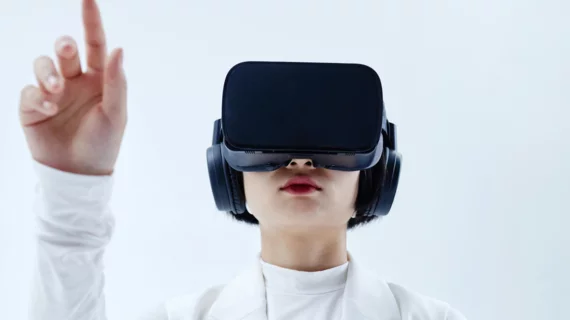Rad techs helpfully ‘stand in a surgeon’s shoes’ thanks to virtual reality
Virtual reality can let surgeons and radiologic technologists plan upcoming operations from one another’s point of view, making for smoothly coordinated movements and closer teamwork during actual operations.
Johns Hopkins researchers demonstrated the worthiness of the concept this year. They describe the project in a study published April 20 in the International Journal of Computer Assisted Radiology and Surgery. [1]
Focusing on X-ray guided trauma surgery of the pelvis, PhD candidate Benjamin Killeen and colleagues tested the technique on 30 non-surgeon novices. They had the participants run through two training interventions: a surgeon intervention and an enabling intervention.
In the “surgeon intervention,” a novice outfitted with VR goggles used X-ray imaging guidance to make like a surgeon and virtually place a thin, metallic Kirschner (or K-) wire along a narrow, bony corridor in a virtual patient. Throughout the exercise the participant communicated with a member of the research team, who took the role of a rad tech, moving a virtual C-arm to supply the “surgeon” with image guidance.
For the “enabling intervention,” the roles were reversed. The participant played the part of a technologist while a researcher portrayed a surgeon.
To validate the exercise, the team repeated the process with an experienced C-arm technologist and an attending physician experienced in orthopedic surgery.
The researchers report several takeaways from the project. Among these:
1. Virtual reality opens up new avenues for training surgical teams, involving exposure to multiple roles. The authors remark:
Here we have shown how experiential knowledge gained in VR can align the shared mental model for non-surgeons, increasing engagement and reducing frustration for individuals performing an enabling task in the OR.
2. Before the surgeon intervention one participant noted their focus on satisfying short-term directives and commented: “I do not know whether the image I acquired is what the surgeon wants.”
After the surgeon intervention, participants’ focus broadened to include overarching goals of the procedure, with one remarking, “It is hard to match the X-ray image to the real patient and K-wire position.”
3. Without experiencing the surgeon task firsthand, participants reliably underestimated the difficulty of completing the procedure.
Experiencing the surgeon’s role improved participants’ understanding of the surgeon task, compared to understanding gained from observation. This is important in the context of teamwork because it allows technologists and other operating room staff to engage with long-term clinical goals and anticipate the related needs of their teammates.
Killeen and co-authors conclude that cross-role VR training can improve teamwork in surgery by “augmenting the shared mental model of non-surgeons” and by “lowering the frustration experienced” in the technologist’s important task.
They suggest additional research might measure participant engagement more directly, possibly using VR headsets with gaze tracking functions.
In the meantime, they offer, “we hope these results pave the way for some training in multiple roles to become a standard part of clinical curricula for surgeons and non-surgeons alike.”

